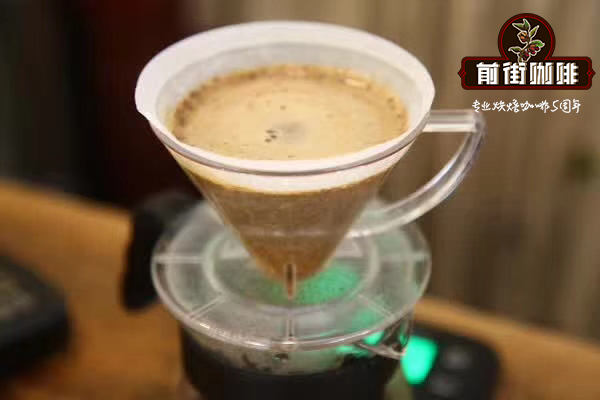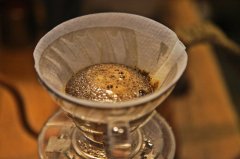The benefit and significance of steaming coffee by hand
For professional baristas, please follow the coffee workshop (Wechat official account cafe_style)
The adequacy of steaming and pre-soaking directly affects the taste of a cup of coffee.
Steaming and pre-soaking
Steaming: refers to the process in which hot water is placed gently, softly, quickly and evenly on the coffee powder to "activate" the coffee powder and release a large amount of carbon dioxide, and the coffee powder will rise upward.
Pre-soaking: when making esp, the water in the head can quickly wet the surface of the coffee cake in 1-2 seconds. The purpose of steaming has two purposes:
First, in order to release the gas in the coffee particles, mainly carbon dioxide. Generally speaking, coffee beans are relatively fresh when roasted, and there are usually more bubbles during pre-soaking. On the other hand, the coffee beans with deeper roasting degree will release more gas during stewing than the coffee beans with lower roasting degree because of their less water content.
Second, if the coffee particles after exhaust gas can be evenly absorbed and saturated, the subsequent extraction can be uniform. In short, during stewing, the air between the coffee powder particles expands and releases a large amount of carbon dioxide, while a short gap layer between the coffee powder particles will provide the space needed for hot water to pass through the powder layer during formal water injection. Successful stewing can fully infiltrate the coffee powder, activate the coffee activity, and form a good gap between the coffee particles, thus making the coffee extraction process more smooth. The so-called activation is to make the coffee powder have a bulging state similar to a volcanic eruption, the coffee powder rises upward, the air between the coffee particles will produce a state of thermal expansion, and the coffee particles themselves will release a large amount of carbon dioxide. Bubble-like voids are formed between the particles, which will make the coffee powder form a uniform filter layer, which can make the hot water pass smoothly during the subsequent hand injection.
The voids formed by good coffee stewing are nearly uniform.

The result of degree extraction, because the extraction time is longer, the dissolved substance is more, the taste may be more sour and irritating, or full of mixed taste. However, once you can pay attention to the action of stewing and start formal water injection, the hot water can pass through the filter layer evenly composed of coffee powder, and then achieve the purpose of uniform extraction. Stewed water injection:
A small amount of ◆: just soak all the coffee powder.
The water absorption of coffee beans with different roasting degrees is different: less water loss in shallow baked beans, low water absorption, more water loss in deep baked beans, and high water absorption.
Generally speaking, 1 gram of coffee powder absorbs water about 2ml.
According to the amount of powder and the degree of roasting, the amount of stewed water is about 1-2 times the weight of coffee powder. For example, I make moderately roasted coffee, 15 grams of powder, injected with 18 grams to 20 grams of water, can soak all the coffee powder.
◆ uniform: all coffee powder is soaked and no water column is formed.
If the water is injected unevenly, it will lead to a lot of water in some areas (water flows down in the form of a water column from the middle of the coffee powder, or a small round hole is formed in the middle of the coffee powder, bubbling upward), and there is no water in some areas (some coffee powder is still dry).
◆ gentle: our goal is to infiltrate and make it dissolve, so just spread the water gently over the coffee powder. Pour water into the stew to keep the spout as close to the noodles as possible. Warm
It is considered that the best temperature for making hand-brewed coffee is 85 degrees, and the highest temperature should not exceed 92 degrees. This kind of water temperature will not produce too much bitterness or sour taste during stewing, and it can also make the coffee fully expand.
Whether a cup of hand-brewed coffee has a pleasant flavor depends largely on whether a good filter layer is formed, except for the nature and freshness of the beans, while stewing will determine whether the hot water can pass evenly through the coffee powder. Stewing is a prelude to coffee extraction and one of the key steps that can not be ignored in coffee extraction.
Important Notice :
前街咖啡 FrontStreet Coffee has moved to new addredd:
FrontStreet Coffee Address: 315,Donghua East Road,GuangZhou
Tel:020 38364473
- Prev

Coffee chocolate sauce pull flower video with coffee chocolate sauce pull flower picture improve coffee pull flower skills
Professional coffee knowledge exchange More coffee bean information Please pay attention to the coffee workshop (Weixin Official Accounts cafe_style) The pull flower at the mouth of the cup makes the coffee price double. Latte means milk in Europe. The artistic pattern lines produced by pouring milk into coffee are Latte Art. This extends to a broader meaning as long as it is on the surface of brewed coffee, making artistic
- Next

What are the variables that have influenced hand-made coffee for a long time?
For a long time, several variables affecting hand-brewed coffee are as follows: 1. Coffee beans; 2. Degree of grinding; 3. Water; 4. Equipment; 5. Steaming time; coffee beans choosing coffee beans that suit your taste is an important criterion to determine whether your cup of coffee tastes good or not. Many people say that it is too light, astringent and miscellaneous, and the first thing we consider is coffee beans. If the roasting degree of coffee beans is too shallow, it will be allowed.
Related
- What is the meaning of lactic acid fermentation with coffee bean treatment?
- How to judge the state of foam by sound?
- How does the latte pull out the unicorn pattern? Come to get for a little trick to improve the flower pull!
- Will flower pulling affect the taste of the latte?
- Do you know the history of coffee?
- The difference between honey treatment and sun washing what is raisin honey treatment?
- What kind of milk can a novice use to make coffee foam to keep the foam longer? The correct method and skills of milking tutorial sharing
- Why do washed coffee beans taste sour? Flavor characteristics of washed Coffee
- Introduction to the skill of how to practice the size and height of water injection around the circle of hand-brewed coffee
- How do beginners practice coffee flower drawing from scratch?

